
Club 3D Radeon HD 7990 6GB Review
Manufacturer: Club 3DUK Price (as reviewed): approx £700 (inc VAT)
US Price (as reviewed): approx $900 (ex Tax)
Despite a supposed leak of details pertaining to an official release of the AMD Radeon HD 7990 6GB card, the card has failed to materialise. Tired of waiting, Club 3D has taken the task upon itself, producing a behemoth £700 graphics card that features a pair of AMD Radeon HD 7970 3GB GPUs running in CrossFire on a single PCB.
Ludicrously expensive it certainly is, but tht £700 price tag still means it's around £70 less than the cheapest Nvidia GTX 690 4GB currently available. That high price means it houses some serious graphics firepower. A single Tahiti Radeon HD 7970 3GB GPU consists of 32 compute units and thus a total of 2,048 stream processors and 128 texture units, alongside 32 ROPs. Club 3D's HD 7990 6GB therefore consists of twice as many of each of these, although both of its GPUs are clocked at the reference frequency of 925MHz rather than the 1.05GHz of the HD 7970 3GB GHz Edition.
The two GPUs are each served by six 64-bit memory controllers, which are in turn connected to two 256MB GDDR5 memory modules each, for a grand total of a whopping 6GB of available graphics memory (3GB per GPU). The memory frequency has also been left at the stock HD 7970 3GB setting of 1.375GHz (5.5GHz effective), giving both GPUs a total memory bandwidth of 264GB/s.
Physically, the length of the custom PCB is 294mm, but the gigantic triple slot cooler extends this measurement to 312mm. With such a large card, it's especially important to ensure that your case can house it, particularly before dropping £700 on it. Weighing in at a massive 1.8KG it's no surprise that Club 3D have included a support column with the card to prevent the PCB from bending over time.
The HD 7990 6GB also sports numerous outputs and supports six-screen Eyefinity, although there's oddly only 5 display outputs. A dual-link DVI and single-link DVI sit alongside two mini DisplayPorts and an HDMI connection on the rear I/O panel. It's here that you'll also find the cards Big Red Button, which when press supposedly overclocks the card's GPUs from 900MHz to 925MHz. This is a fairly pointless and minimal overclock, and in testing we found that the GPUs boosted to 925MHz under load regardless of whether or not the button was pressed in. A CrossFire bridge is provided for anyone crazy enough to want to run two of these monsters together in Quad CrossFireX mode.
The monstrous cooler and its housing are what lend the card its hefty weight. Two copper baseplates (one per GPU) are connected to the aluminium fin stacks by five heatpipes each. This massive clump of metal is cooled by the two side 92mm fans and single 80mm fan in the middle. The black metal enclosure will ensure that much of the card's hot air will find its way out of the rear of your case, but some will still be exhausted back into your case's internals.
The custom PCB houses one GPU in the middle of the circuit board and the second near the rear I/O panel, and these are connected by an onboard CrossFire bridge between them. The power circuitry runs along the side and top of the board, and consists of six phases for each GPU and two for each set of memory chips, for a total of 16+1 power phases, compared to the 6+1 power phases of the original. To say that the card is power hungry is an understatement – you'll need an 850W power supply minimum and three spare 8-pin PCI-E connections to run it.
Fixed metal heatsinks along the front of the PCB provide some cooling for the VRMs as well as the CrossFire bridge. The twelve memory chips on this side of the board are left uncovered, but the board also has another twelve memory chips on its rear. These chips receive passive cooling from the large metal black plate that spans the whole length of the PCB, and which utilises foam contact pads to absorb and draw away heat from the memory modules.

MSI MPG Velox 100R Chassis Review
October 14 2021 | 15:04

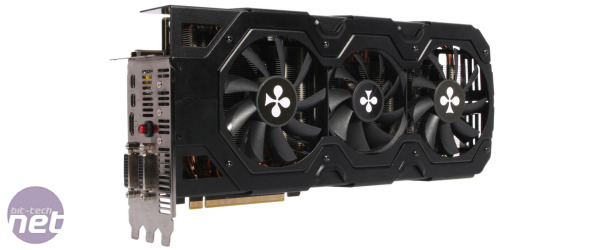
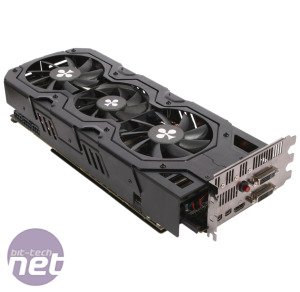
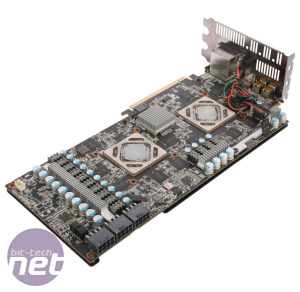
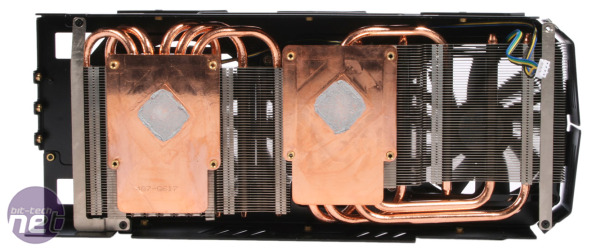
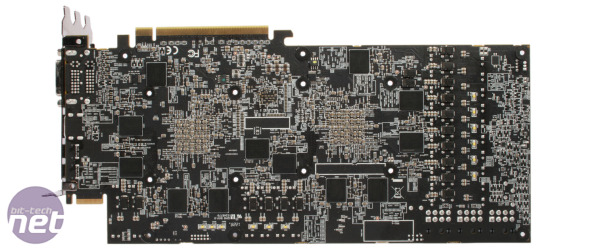







Want to comment? Please log in.